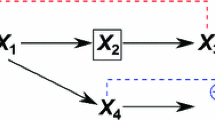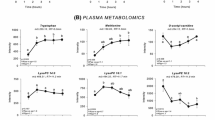Abstract
The changes in the concentrations of plasma amino acids do not always follow the flow-based metabolic pathway network. We have previously shown that there is a control-based network structure among plasma amino acids besides the metabolic pathway map. Based on this network structure, in this study, we performed dynamic analysis using time-course data of the plasma samples of rats fed single essential amino acid deficient diet. Using S-system model (conceptual mathematical model represented by power-law formalism), we inferred the dynamic network structure which reproduces the actual time-courses within the error allowance of 13.17%. By performing sensitivity analysis, three of the most dominant relations in this network were selected; the control paths from leucine to valine, from methionine to threonine, and from leucine to isoleucine. This result is in good agreement with the biological knowledge regarding branched-chain amino acids, and suggests the biological importance of the effect from methionine to threonine.







Similar content being viewed by others
References
Brindle JT, Antti H, Holmes E, Tranter G, Nicholson JK, Bethell HW, Clarke S, Schofield PM, McKilligin E, Mosedale DE, Grainger DJ (2002) Rapid and noninvasive diagnosis of the presence and severity of coronary heart disease using 1H-NMR-based metabonomics. Nat Med 8:1439–1444. doi:10.1038/nm802
Brosnan JT, Brosnan ME (2006) Branched-chain amino acids: enzyme and substrate regulation. J Nutr 136:207S–211S
Cooper GF, Herskovits E (1992) A Bayesian method for the induction of probabilistic networks from data. Mach Learn 9:309
Dahlquist KD, Salomonis N, Vranizan K, Lawlor SC, Conklin BR (2002) GenMAPP, a new tool for viewing and analyzing microarray data on biological pathways. Nat Genet 31:19–20. doi:10.1038/ng0502-19
Felig P (1975) Amino acid metabolism in man. Annu Rev Biochem 44:933–955. doi:10.1146/annurev.bi.44.070175.004441
Ferenci P, Wewalka F (1978) Plasma amino acids in hepatic encephalopathy. J Neural Transm Suppl 14:87–94
Friedman N, Linial M, Nachman I, Pe’er D (2000) Using Bayesian networks to analyze expression data. J Comput Biol 7:601–620. doi:10.1089/106652700750050961
Harris RA, Joshi M, Jeoung NH (2004) Mechanisms responsible for regulation of branched-chain amino acid catabolism. Biochem Biophys Res Commun 313:391–396. doi:10.1016/j.bbrc.2003.11.007
Holm E, Sedlaczek O, Grips E (1999) Amino acid metabolism in liver disease. Curr Opin Clin Nutr Metab Care 2:47–53. doi:10.1097/00075197-199901000-00009
Hong SY, Yang DH, Chang SK (1998) The relationship between plasma homocysteine and amino acid concentrations in patients with end-stage renal disease. J Ren Nutr 8:34–39. doi:10.1016/S1051-2276(98)90035-8
Imoto S, Goto T, Miyano S (2002) Estimation of genetic networks and functional structures between genes by using Bayesian networks and nonparametric regression. Pac Symp Biocomput, pp 175–186
Katz RS, Baker DH (1975) Methionine toxicity in the chick: nutritional and metabolic implications. J Nutr 105:1168–1175
Kikuchi S, Tominaga D, Arita M, Takahashi K, Tomita M (2003) Dynamic modeling of genetic networks using genetic algorithm and S-system. Bioinformatics 19:643–650. doi:10.1093/bioinformatics/btg027
Maki Y, Tominaga D, Okamoto M, Watanabe S, Eguchi Y (2001) Development of a system for the inference of large scale genetic networks. Pac Symp Biocomput, pp 446–458
Maki Y, Takahashi Y, Arikawa Y, Watanabe S, Aoshima K, Eguchi Y, Ueda T, Aburatani S, Kuhara S, Okamoto M (2004) An integrated comprehensive workbench for inferring genetic networks: VoyaGene. J Bioinform Comput Biol 2:533–550. doi:10.1142/S0219720004000727
Nakatsui M, Ueda T, Maki Y, Ono I, Okamoto M (2008) Method for inferring and extracting reliable genetic interactions from time-series profile of gene expression. Math Biosci 215:105–114. doi:10.1016/j.mbs.2008.06.007
Nicholson JK, Lindon JC, Holmes E (1999) ‘Metabonomics’: understanding the metabolic responses of living systems to pathophysiological stimuli via multivariate statistical analysis of biological NMR spectroscopic data. Xenobiotica 29:1181–1189. doi:10.1080/004982599238047
Noguchi Y, Zhang QW, Sugimoto T, Furuhata Y, Sakai R, Mori M, Takahashi M, Kimura T (2006) Network analysis of plasma and tissue amino acids and the generation of an amino index for potential diagnostic use. Am J Clin Nutr 83:513S–519S
Obeid OA (2005) Plasma amino acid concentrations in patients with coronary heart disease: a comparison between U.K. Indian Asian and Caucasian men. Int J Vitam Nutr Res 75:267–273. doi:10.1024/0300-9831.75.4.267
Ogata H, Goto S, Sato K, Fujibuchi W, Bono H, Kanehisa M (1999) KEGG: Kyoto Encyclopedia of Genes and Genomes. Nucleic Acids Res 27:29–34
Ohtsuka Y, Agishi Y (1992) Abnormal amino acid metabolism in diabetes mellitus. Nippon Rinsho 50:1631–1636
Ono I, Kobayashi S (1997) A real-coded genetic algorithm for function optimization using unimodal distribution crossover. 7th ICGA pp 249–253
Parker PJ, Randle PJ (1978) Inactivation of rat heart branched-chain 2-oxoacid dehydrogenase complex by adenosine triphosphate. FEBS Lett 95:153–156. doi:10.1016/0014-5793(78)80072-6
Sato H, Ono I, Kobayashi S (1997) A new generation alternation model of genetic algorithm and its assessment. J. Jpn Soc Artif Intell 12:734–744
Savageau MA (1976) Biochemical systems analysis: a study of function and design in molecular biology. Addison-Wesley, Reading
Savageau MA (1998) Rules for the evolution of gene circuitry. Pac Symp Biocomput, pp 54–65
Shikata N, Maki Y, Noguchi Y, Mori M, Hanai T, Takahashi M, Okamoto M (2007) Multi-layered network structure of amino acid (AA) metabolism characterized by each essential AA-deficient condition. Amino Acids 33:113–121. doi:10.1007/s00726-006-0412-0
Soeters PB, Fischer JE (1976) Insulin, glucagon, aminoacid imbalance, and hepatic encephalopathy. Lancet 2:880–882. doi:10.1016/S0140-6736(76)90541-9
Soltesz G, Schultz K, Mestyan J, Horvath I (1978) Blood glucose and plasma amino acid concentrations in infants of diabetic mothers. Pediatrics 61:77–82
Somogyi R, Sniegoski CA (1996) Modeling the complexity of genetic networks: understanding multigenetic and pleiotropic regulation. Complexity 1:45–63
Ueda T, Koga N, Ono I, Okamoto M (2002) Efficient numerical optimization technique based on real-coded genetic altorithm for inverse problem. 7th international symposium on artificial life and robotics (AROB 7th ‘02), 290–293
Watanabe A, Higashi T, Sakata T, Nagashima H (1984) Serum amino acid levels in patients with hepatocellular carcinoma. Cancer 54:1875–1882. doi:10.1002/1097-0142(19841101)54:9<1875::AID-CNCR2820540918>3.0.CO;2-O
Weinlich G, Murr C, Richardsen L, Winkler C, Fuchs D (2007) Decreased serum tryptophan concentration predicts poor prognosis in malignant melanoma patients. Dermatology 214:8–14. doi:10.1159/000096906
Acknowledgment
This work was partially supported by Grants-in-Aid for Scientific Research (c) [No. 18500228(YM)] and Scientific Research on Priority Areas, ‘New IT Infrastructure for the Information-explosion Era’ [No. 18049073(MO)] from the Ministry of Education, Culture, Sports, Science and Technology, Japan.
Author information
Authors and Affiliations
Corresponding author
Rights and permissions
About this article
Cite this article
Shikata, N., Maki, Y., Nakatsui, M. et al. Determining important regulatory relations of amino acids from dynamic network analysis of plasma amino acids. Amino Acids 38, 179–187 (2010). https://doi.org/10.1007/s00726-008-0226-3
Received:
Accepted:
Published:
Issue Date:
DOI: https://doi.org/10.1007/s00726-008-0226-3




